Effects of Biochar Application on Vegetation Growth, Cover, and Erosion Potential in Sloped Cultivated Soil Derived from Mudstone
Abstract
:1. Introduction
2. Materials and Methods
2.1. Experimental Sites and Soil
2.2. Biochars
2.3. Field Erosion Experiment
2.4. Analytical Methods
2.5. Statistical Analysis
3. Results and Discussion
3.1. Effects of Biochar Application on Soil Properties, Soil Losses, and Vegetation Growing in Mudstone Soil
3.2. Relationship between VC and Soil Erosion Amount
4. Conclusions
Author Contributions
Funding
Institutional Review Board Statement
Informed Consent Statement
Data Availability Statement
Acknowledgments
Conflicts of Interest
References
- Leh, M.; Bajwa, S.; Chaubey, I. Impact of land use change on erosion risk: An integrated remote sensing, geographic information system and modeling methodology. Land Degrad. Dev. 2013, 24, 409–421. [Google Scholar] [CrossRef]
- Ziadat, F.M.; Taimeh, A.Y. Effect of rainfall intensity, slope, land use and antecedent soil moisture on soil erosion in an arid environment. Land Degrad. Dev. 2013, 24, 582–590. [Google Scholar] [CrossRef]
- Qadir, M.; Noble, A.D.; Chartres, C. Adapting to climate change by improving water productivity of soils in dry areas. Land Degrad. Dev. 2013, 24, 12–21. [Google Scholar] [CrossRef]
- Mandal, D.; Sharda, V.N. Appraisal of soil erosion risk in the eastern himalayan region of india for soil conservation planning. Land Degrad. Dev. 2013, 24, 430–437. [Google Scholar] [CrossRef]
- Ayoubi, S.; Mokhtari, J.; Mosaddeghi, M.R.; Zeraatpisheh, M. Erodibility of calcareous soils as influenced by land use and intrinsic soil properties in a semiarid region of central Iran. Environ. Monit. Assess. 2018, 190, 192. [Google Scholar] [CrossRef] [PubMed]
- Taghizadeh-Mehrjardi, R.; Bawa, A.; Kumar, S.; Zeraatpisheh, M.; Amirian-Chakan, A.; Akbarzadeh, A. Soil Erosion Spatial Prediction using Digital Soil Mapping and RUSLE methods for Big Sioux River Watershed. Soil Syst. 2019, 3, 43. [Google Scholar] [CrossRef] [Green Version]
- Tarolli, P.; Straffelini, E. Agriculture in hilly and mountainous landscapes: Threats, monitoring and sustainable management. Geogr. Sustain. 2020, 1, 70–76. [Google Scholar] [CrossRef]
- Wang, Q.J.; Zhao, G.X.; Liu, Y.L.; Zhang, P.Y.; Chai, J. Effects of vegetation types on yield of surface runoff and sediment, loss of nitrogen and phosphorus along loess slope land. Soc. Agric. Eng. 2016, 32, 195–201. (In Chinese) [Google Scholar]
- Chan, K.Y.; Van Zwieten, L.; Meszaros, I.; Downie, A.; Joseph, S. Agronomic values of greenwaste biochar as a soil amendment. Aust. J. Soil Res. 2007, 45, 629–634. [Google Scholar] [CrossRef]
- Chan, K.Y.; van Zwieten, L.; Meszaros, I.; Downie, A.; Joseph, S. Using poultry litter biochars as soil amendments. Aust. J. Soil Res. 2008, 46, 437–444. [Google Scholar] [CrossRef]
- Van Zwieten, L.; Kimber, S.; Morris, S.; Chan, K.Y.; Downie, A.; Rust, J.; Joseph, S.; Cowie, A. Effects of biochar from slow pyrolysis of papermill waste on agronomic performance and soil fertility. Plant Soil 2010, 327, 235–246. [Google Scholar] [CrossRef]
- Deenik, J.L.; Diarra, A.; Uehara, G.; Campbell, S.; Sumiyoshi, Y.; Antal, M.J., Jr. Charcoal ash and volatile matter effects on soil properties and plant growth in an acid ultisol. Soil Sci. 2011, 176, 336–345. [Google Scholar] [CrossRef]
- Jien, S.H.; Wang, C.C.; Lee, C.H.; Lee, T.Y. Stabilization of organic matter by biochar application in compost-amended soils with contrasting pH values and textures. Sustainability 2015, 7, 13317–13333. [Google Scholar] [CrossRef] [Green Version]
- Atkinson, C.J.; Fitzgerald, J.D.; Hipps, N.A. Potential mechanisms for achieving agricultural benefits from biochar application to temperate soils: A review. Plant Soil 2010, 337, 1–18. [Google Scholar] [CrossRef]
- Jien, S.H.; Wang, C.S. Effects of biochar on soil properties and erosion potential in a highly weathered soil. Catena 2013, 110, 225–233. [Google Scholar] [CrossRef] [Green Version]
- Cerdà, A. Aggregate stability against water forces under different climates on agriculture land and scrubland in southern Bolivia. Soil Tillage Res. 2000, 57, 159–166. [Google Scholar] [CrossRef]
- Kimetu, J.M.; Lehmann, J. Stability and stabilisation of biochar and green manure in soil with different organic carbon contents. Aust. J. Soil Res. 2010, 48, 577–585. [Google Scholar] [CrossRef]
- Dimoyiannis, D. Wet aggregate stability as affected by excess carbonate and other soil properties. Land Degrad. Dev. 2012, 23, 450–455. [Google Scholar] [CrossRef]
- Kocyigit, R.; Demirci, S. Long-term changes of aggregate associated and labile soil organic carbon and nitrogen after conversion from forest to grassland and cropland in northern Turkey. Land Degrad. Dev. 2012, 23, 475–482. [Google Scholar] [CrossRef]
- Herath, H.M.S.K.; Camps-Arbestain, M.; Hedley, M. Effect of biochar on soil physical properties in two contrasting soils: An Alfisol and an Andisol. Geoderma 2013, 209–210, 188–197. [Google Scholar] [CrossRef]
- Lehmann, J.; Rhodon, M. Biochar soil management on highly weathered soils in the humid tropics. Biol. Approaches Sustain. Soil Syst. 2006, 113, 517–540. [Google Scholar]
- Steiner, C.; Melear, N.; Harris, K.; Das, K. Biochar as bulking agent for poultry litter composting. Carbon Manag. 2011, 2, 227–230. [Google Scholar] [CrossRef]
- Laird, D.A.; Fleming, P.; Davis, D.D.; Horton, R.; Wang, B.; Karlen, D.L. Impact of biochar amendments on the quality of a typical Midwestern agricultural soil. Geoderma 2010, 158, 443–449. [Google Scholar] [CrossRef] [Green Version]
- Yuan, J.H.; Xu, R.K. The amelioration effects of low temperature biochar generated from nine crop residues on an acidic Ultisol. Soil Use Manag. 2011, 27, 110–115. [Google Scholar] [CrossRef]
- Trompowsky, P.M.; De Melo Benites, V.; Madari, B.E.; Pimenta, A.S.; Hockaday, W.C.; Hatcher, P.G. Characterization of humic like substances obtained by chemical oxidation of eucalyptus charcoal. Org. Geochem. 2005, 36, 1480–1489. [Google Scholar] [CrossRef]
- Tejada, M.; Gonzalez, J.L. Influence of organic amendments on soil structure and soil loss under simulated rain. Soil Tillage Res. 2007, 93, 197–205. [Google Scholar] [CrossRef]
- Wuddivira, M.N.; Stone, R.J.; Ekwue, E.I. Structural stability of humid tropical soils as influenced by manure incorporation and incubation duration. Soil Sci. Soc. Am. J. 2009, 73, 1353–1360. [Google Scholar] [CrossRef]
- Materechera, S.A. Aggregation in a surface layer of a hardsettingand crusting soil as influenced by the application of amendments and grass mulch in a South African semi-arid environment. Soil Tillage Res. 2009, 105, 251–259. [Google Scholar] [CrossRef]
- Jindo, K.; Matsumoto, K.; Garćıa Izquierdo, C.; Sonoki, T.; Sanchez-Monedero, M.A. Methodological interference of biochar in the determination of extracellular enzyme activities in composting samples. Soil Earth 2014, 5, 713–719. [Google Scholar] [CrossRef] [Green Version]
- Mukherjee, A.; Lal, R.; Zimmerman, A.R. Effects of biochar and other amendments on the physical properties and greenhouse gas emissions of an artificially degraded soil. Sci. Total Environ. 2014, 487, 26–36. [Google Scholar] [CrossRef]
- Ghezzehei, T.A.; Sarkhot, D.V.; Berhe, A.A. Biochar can be used to capture essential nutrients fromdairy wastewater and improve soil physico-chemical properties. Soil Earth 2014, 5, 953–962. [Google Scholar] [CrossRef] [Green Version]
- Hseu, Z.Y.; Jien, S.H.; Chien, W.H.; Liou, R.C. Impacts of Biochar on Physical Properties and Erosion Potential of a Mudstone Slopeland Soil. Sci. World J. 2014, 2014, 602197. [Google Scholar] [CrossRef] [PubMed]
- Wischmeier, W.H.; Smith, D.D. Prediction Rainfall Erosion Losses from Cropland East of the Rocky Mountains: A Guide for Selection of Practices for Soil and Water Conservation. In Agricultural Handbook; US Department of Agriculture: Washington, DC, USA, 1965; 47p. [Google Scholar]
- Lee, D.H.; Jhin, Y.Y.; Tien, K.G. The basic characteristics of mudstone and the protection methods for mudstone slope. Sino-Geotechnics 1994, 48, 35–47. [Google Scholar]
- Soil Survey Staff, Keys to Soil Taxonomy. In Agricultural Handbook No. 436, 12th ed.; United States Department of Agriculture: Washington, DC, USA, 2014.
- Dhanachandra, N.; Manglem, K.; Chanu, Y.J. Image Segmentation Using K-means Clustering Algorithm and Subtractive Clustering Algorithm. Procedia Comput. Sci. 2015, 54, 764–771. [Google Scholar] [CrossRef] [Green Version]
- Blake, G.R.; Hartge, K.H. Bulk Density. Methods Soil Anal. Part 1 Phys. Miner. Method 1986, 3, 363–382. [Google Scholar]
- McLean, E. Soil pH and lime requirement. Methods Soil Anal. Part 2 Chem. Microbiol. Prop. 1982, 9, 199–224. [Google Scholar]
- Rhoades, J. Cation exchange capacity. Methods Soil Anal. Part 2 Chem. Microbiol. Prop. 1982, 9, 149–157. [Google Scholar]
- Gee, G.W.; Bauder, J.W.; Klute, A. Particle-size analysis. Methods Soil Anal. Part 1 Phys. Mineral. Methods 1986, 61, 383–411. [Google Scholar]
- Sumner, M.E.; Miller, W.P. Cation exchange capacity and exchange coecients. Methods Soil Anal. Soil Sci. Soc. Am. Book Ser. 5 Part 3—Chem. Methods 1996, 5, 1201–1229. [Google Scholar]
- Nelson, D.W.; Sommer, L.E. Total Carbon, Organic Carbon and Organic Matter. Methods Soil Anal. Part 2 Chem. Microbiol. Prop. 1982, 9, 539–579. [Google Scholar]
- Bray, R.H.; Kurtz, L. Determination of total, organic, and available forms of phosphorus in soils. Soil Sci. 1945, 59, 39–46. [Google Scholar] [CrossRef]
- Mulvaney, R.L. Nitrogen-Inorganic forms. Methods Soil Anal. Soil Sci. Soc. Am. Book Ser. 5 Part 3—Chem. Methods 1996, 9, 1123–1184. [Google Scholar]
- Busscher, W.J.; Novak, J.M.; Evans, D.E.; Watts, D.W.; Niandou, M.; Ahmedna, M. Influence of pecan biochar on physical properties of a Norfolk loamy sand. Soil Sci. 2010, 175, 10–14. [Google Scholar] [CrossRef] [Green Version]
- Chen, J.; Xiao, H.; Li, Z.; Liu, C.; Wang, D.; Wang, L.; Tang, C. Threshold effects of vegetation coverage on soil erosion control in small watersheds of the red soil hilly region in China. Ecol. Eng. 2019, 132, 109–114. [Google Scholar] [CrossRef]
- Liao, C.S.; Xie, Z.H.; Jien, S.H. Decomposition and Nutrient Releasing of Biochar Compound Materials in Soil with Different Textures. Processes 2021, 9, 1521. [Google Scholar] [CrossRef]
- Lehmann, J.; Joseph, S. Biochar for Environmental Management; Earthscan Publishers Ltd.: London, UK, 2009. [Google Scholar]
- Sohi, S.; Loez-Capel, E.; Krull, E.; Bol, R. Biochar’s Roles in Soil and Climate Change: A Review of Research Needs. CSIRO Land Water Sci. Rep. 2009, 5, 1–57. [Google Scholar]
- Zhang, A.; Liu, Y.; Pan, G.; Hussain, Q.; Li, L.; Zheng, J.; Zhang, X. Effect of biochar amendment on maize yield and greenhouse gas emission from a soil organic carbon poor calcareous loamy soil from Central China Plain. Plant Soil 2012, 351, 263–275. [Google Scholar] [CrossRef]
- Bai, Z.G.; Dent, D.L.; Olsson, L.; Schaepman, M.E. Proxy global assessment of land degradation. Soil Use Manag. 2008, 24, 223–224. [Google Scholar] [CrossRef]
- Li, X.Y.; Wang, Z.M.; Song, K.S.; Zhang, B.; Liu, D.W.; Guo, Z.X. Assessment for salinized wasteland expansion and land use change using GIS and remote sensing in the west part of Northeast China. Environ. Monit Assess 2007, 131, 421–437. [Google Scholar] [CrossRef]
- Lashari, M.S.; Liu, Y.; Li, L.; Pan, W.; Fu, J.; Pan, G.; Zheng, J.; Zheng, J.; Zhang, X.; Yu, X. Effects of Amendment of Biochar-Manure Compost in Conjunction with Pyroligneous Solution on Soil Quality and Wheat Yield of a Salt-Stressed Cropland from Central China Great Plain. Field Crops Res. 2013, 144, 113–118. [Google Scholar] [CrossRef]
- Zhao, B.Q.; Zhang, L.; Xia, Z.Y.; Xu, W.N.; Liang, Y.Z.; Xia, D. Effects of rainfall intensity and vegetation cover on erosion characteristics of a soil containing rock fragments slope. Adv. Civ. Eng. 2019, 2019, 1–14. [Google Scholar] [CrossRef]
- Sirjani, E.; Mahmoodabadi, M. Effects of sheet flow rate and slope gradient on sediment load. Arab. J. Geosci. 2014, 7, 203–210. [Google Scholar] [CrossRef]
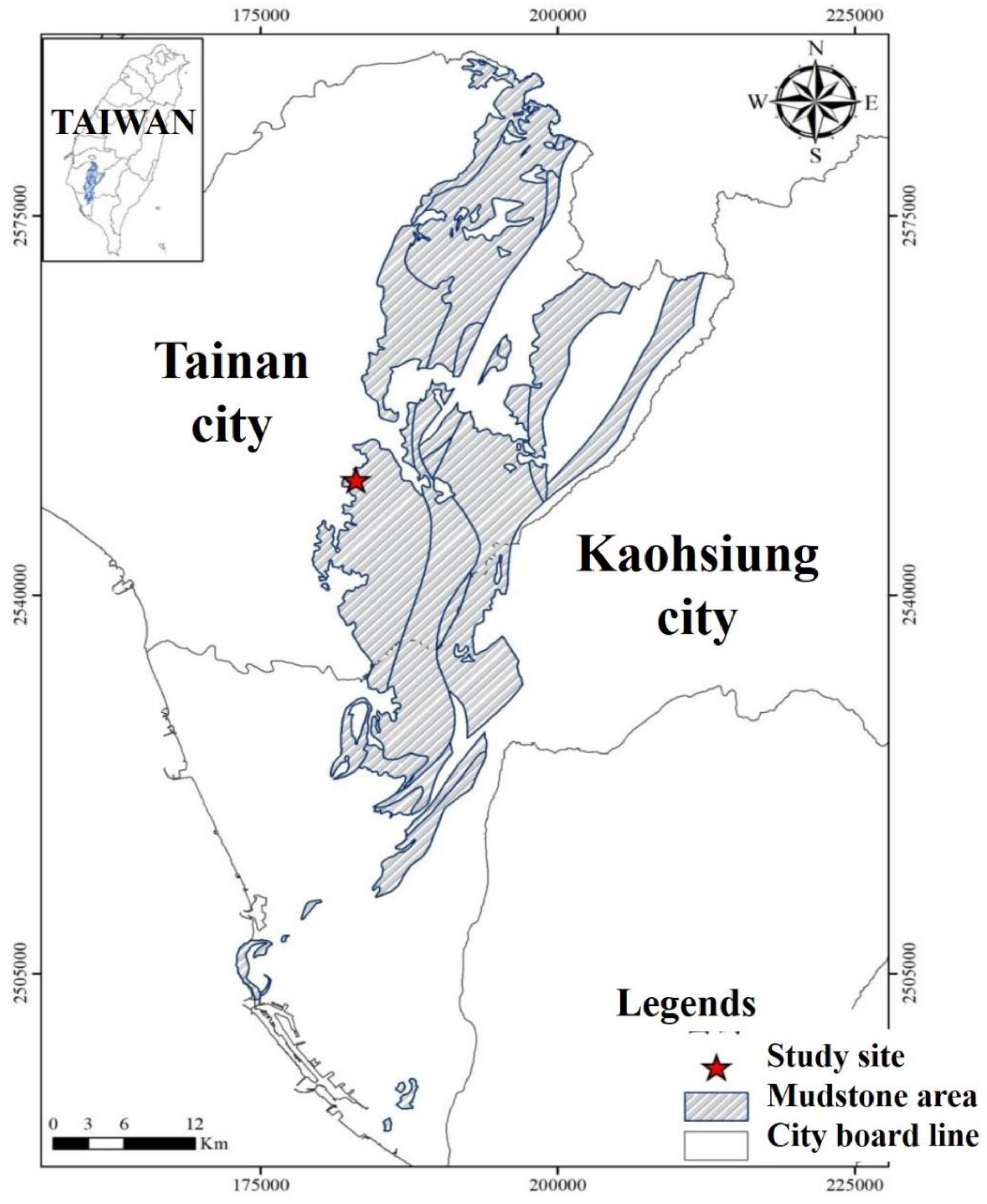
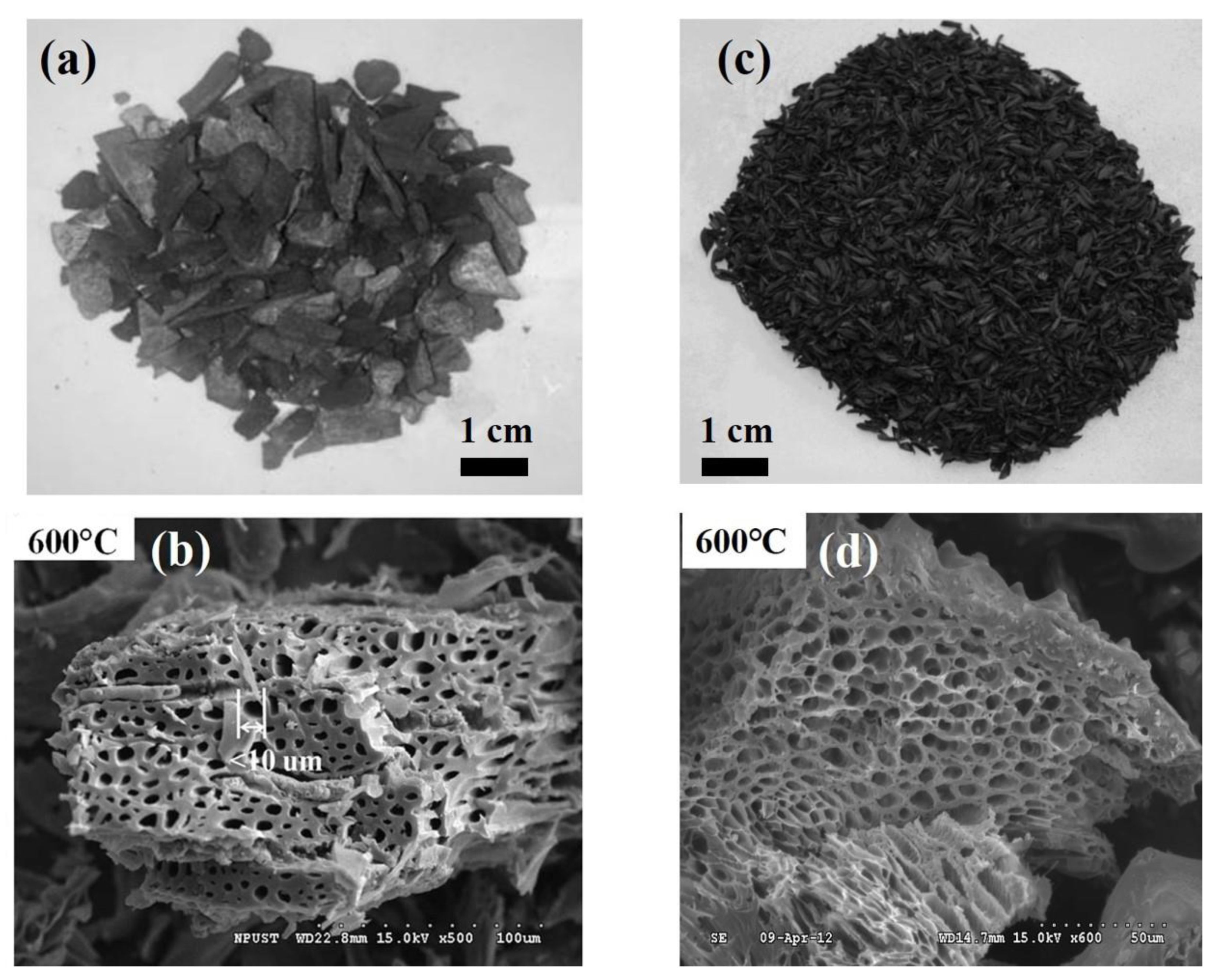
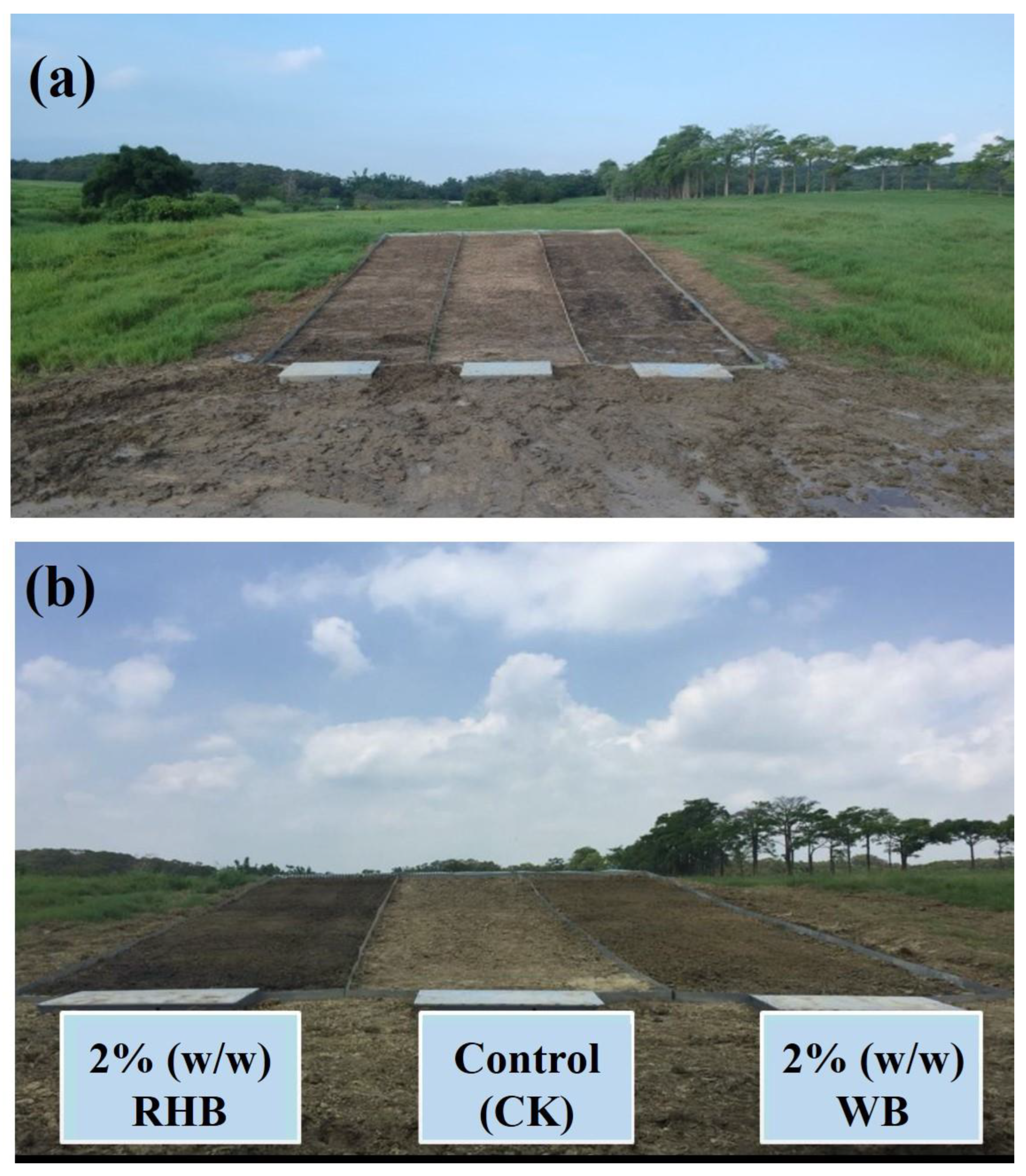

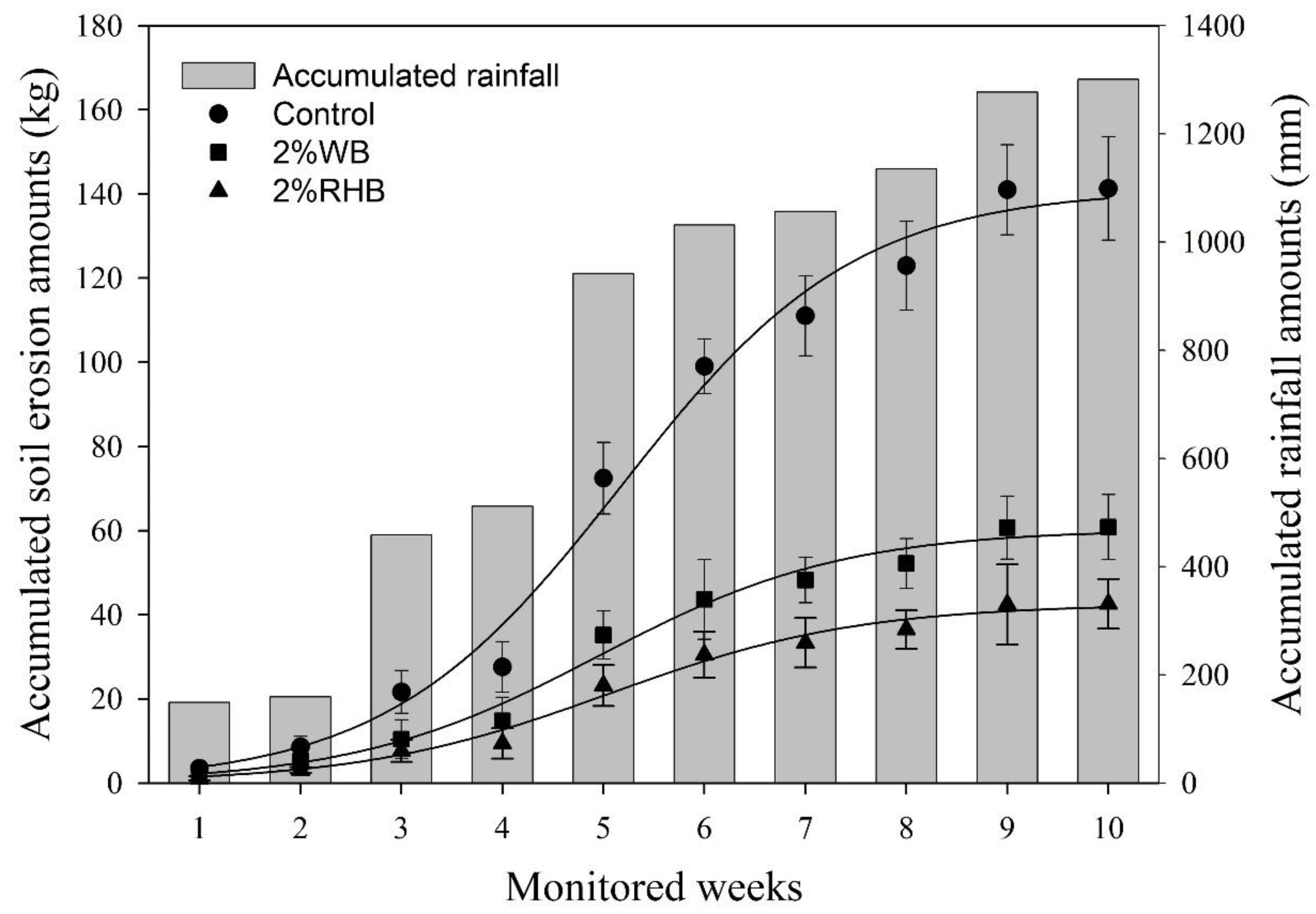
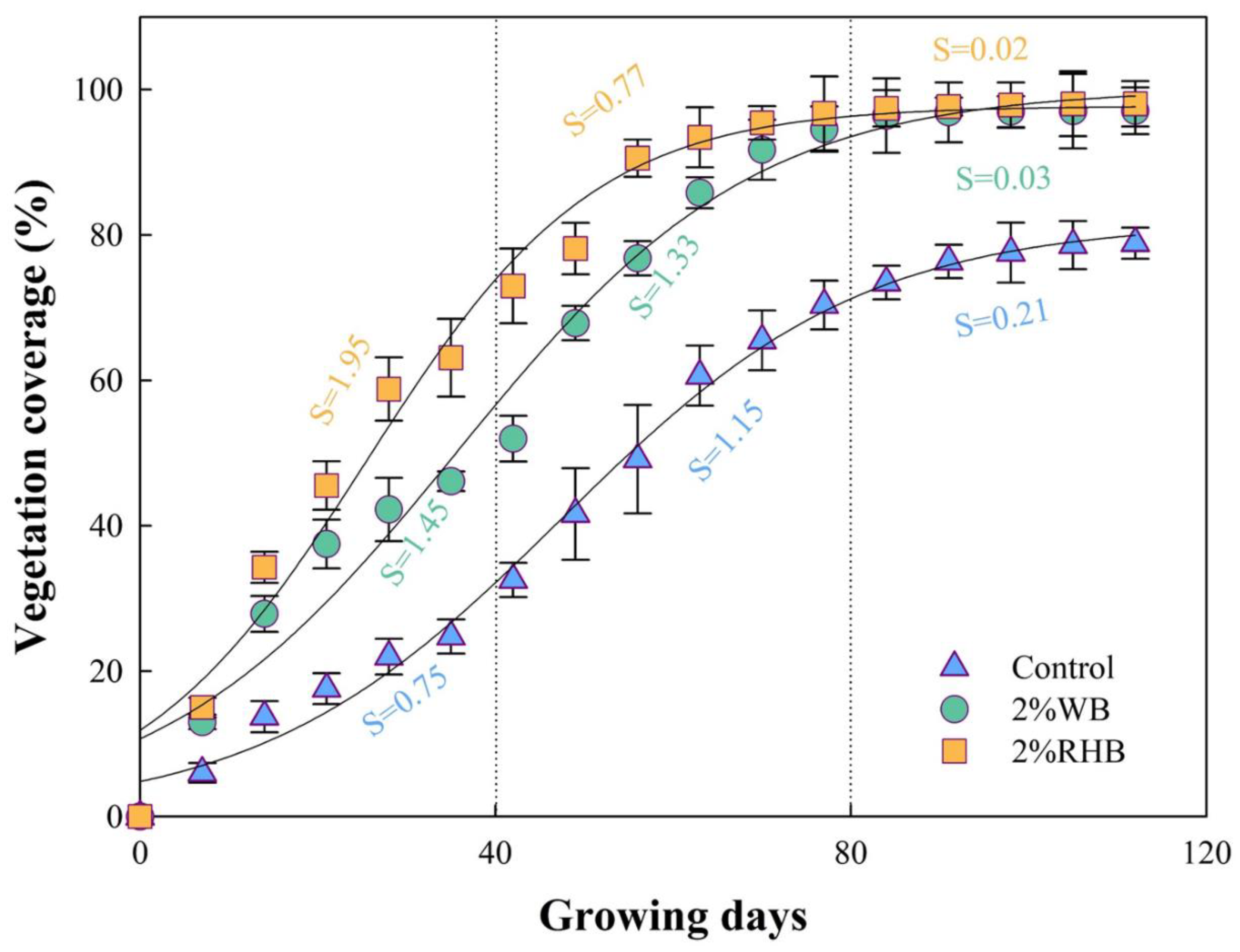

| Soil | WB | RHB | |
|---|---|---|---|
| Texture | Silty clay loam | - | - |
| Sand (%) | 16 | - | - |
| Silt (%) | 54 | - | - |
| Clay (%) | 30 | - | - |
| Bd (g/cm3) | 1.52 ± 0.05 | - | - |
| pH | 7.09 ± 0.03 | 7.79 ± 0.06 | 8.86 ± 0.04 |
| EC (dS/m) | 3.56 ± 1.06 | 0.15 ± 0.07 | 0.11 ± 0.05 |
| OC (%) | 1.23 ± 0.35 | 3.47 ± 0.21 | 2.53 ± 0.04 |
| TC (%) | 3.55 ± 0.53 | 43.4 ± 1.25 | 47.1 ± 2.21 |
| NH4+-N (mg/kg) | 16.5 ± 2.13 | 36.2 ± 5.17 | 4.53 ± 0.54 |
| NO3−-N (mg/kg) | 36.1 ± 8.07 | 49.5 ± 4.63 | 18.3 ± 2.17 |
| Av. P (mg/kg) | 4.19 ± 0.65 | 28.4 ± 1.17 | 25.7 ± 1.55 |
| CEC (cmol(+)/kg) | 12.8 ± 2.09 | 13.5 ± 2.17 | 14.6 ± 2.36 |
| TN (mg/kg) | 648 ± 78.8 | 418 ± 66.8 | 357 ± 51.2 |
| Control | 2%WB | 2%RHB | ||||
|---|---|---|---|---|---|---|
| Days after Biochar Incorporation | 1 | 120 | 1 | 120 | 1 | 120 |
| Bulk density (g cm−3) | 1.23 ± 0.02 bA | 1.55 ± 0.01 aA | 1.20 ± 0.02 bA | 1.29 ± 0.01 aC | 1.21 ± 0.01 bA | 1.32 ± 0.02 aB |
| pH | 7.09 ± 0.00 aC | 7.08 ± 0.02 bC | 7.19 ± 0.00 aB | 7.14 ± 0.02 bB | 7.26 ± 0.00 aA | 7.20 ± 0.01 bA |
| EC (dS m−1) | 3.56 ± 0.10 aA | 3.10 ± 0.00 bB | 3.47 ± 0.15 aA | 3.48 ± 0.06 aA | 3.44 ± 0.15 aA | 3.46 ± 0.03 aA |
| OC (%) | 1.23 ± 0.04 aB | 1.20 ± 0.04 aA | 2.09 ± 0.03 aA | 1.32 ± 0.07 bA | 2.17 ± 0.07 aA | 1.32 ± 0.04 bA |
| NH3+-N (mg kg−1) | 16.5 ± 1.67 aB | 18.0 ± 0.86 aB | 20.5 ± 1.59 aA | 22.5 ± 1.35 aA | 9.00 ± 0.08 bC | 15.0 ± 1.55 aB |
| NO4−-N (mg kg−1) | 36.0 ± 3.55 aA | 16.5 ± 2.00 bA | 42.0 ± 3.39 aA | 19.5 ± 2.41 bA | 28.0 ± 1.27 aB | 15.0 ± 1.27 bA |
| Av.P (mg kg−1) | 4.19 ± 0.36 aA | 2.16 ± 0.18 bA | 4.12 ± 0.44 aA | 2.36 ± 0.19 bA | 4.11 ± 0.35 aA | 2.45 ± 0.20 bA |
| CEC (cmol kg−1) | 12.8 ± 1.06 aA | 12.7 ± 0.94 aA | 13.0 ± 1.63 aA | 12.9 ± 2.16 aA | 13.2 ± 0.53 aA | 13.0 ± 1.63 aA |
| TN (mg kg−1) | 648 ± 44.0 aA | 472 ± 65.0 bA | 637 ± 108 aA | 548 ± 43.0 aA | 614 ± 29.0 aA | 521 ± 32.0 bA |
| CEC: cation exchange capacity. | ||||||
| Model | Function | Adjusted R2 | Variables | Beta (β) | Explained Variation | VIF | Significance |
|---|---|---|---|---|---|---|---|
| 1 | EA = −0.435 × ln(VC) + 0.54 × RKE | 0.793 | Log (VC) | −0.435 | 14% | 1.114 | 0.005 (<0.01) |
| RKET | 0.540 | 43% | 1.114 | 0.001 (<0.01) |
Publisher’s Note: MDPI stays neutral with regard to jurisdictional claims in published maps and institutional affiliations. |
© 2022 by the authors. Licensee MDPI, Basel, Switzerland. This article is an open access article distributed under the terms and conditions of the Creative Commons Attribution (CC BY) license (https://creativecommons.org/licenses/by/4.0/).
Share and Cite
Lee, M.-H.; Lin, H.-H.; Jien, S.-H. Effects of Biochar Application on Vegetation Growth, Cover, and Erosion Potential in Sloped Cultivated Soil Derived from Mudstone. Processes 2022, 10, 306. https://doi.org/10.3390/pr10020306
Lee M-H, Lin H-H, Jien S-H. Effects of Biochar Application on Vegetation Growth, Cover, and Erosion Potential in Sloped Cultivated Soil Derived from Mudstone. Processes. 2022; 10(2):306. https://doi.org/10.3390/pr10020306
Chicago/Turabian StyleLee, Ming-Hsi, Huan-Hsuan Lin, and Shih-Hao Jien. 2022. "Effects of Biochar Application on Vegetation Growth, Cover, and Erosion Potential in Sloped Cultivated Soil Derived from Mudstone" Processes 10, no. 2: 306. https://doi.org/10.3390/pr10020306
APA StyleLee, M.-H., Lin, H.-H., & Jien, S.-H. (2022). Effects of Biochar Application on Vegetation Growth, Cover, and Erosion Potential in Sloped Cultivated Soil Derived from Mudstone. Processes, 10(2), 306. https://doi.org/10.3390/pr10020306






